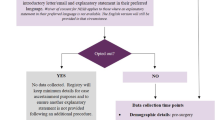Abstract
Pelvic floor disorders affect millions of women nationwide and many women access the healthcare system to seek treatment for these disorders to improve their quality of life. Quality improvement is defined as the combined and unceasing efforts of healthcare professionals, patients and their families, researchers, payers, planners and educators to make the changes that will lead to better patient outcomes, professional development and health care delivery. The problems related to transvaginal mesh emphasize the importance of quality and safety in the field of female pelvic medicine and reconstruction. In the future, medical societies will likely increase the production of treatment guidelines for disease processes and certifying medical boards will continue to strengthen the certification and maintenance of certifications processes in order to maintain competency and improve the quality and safety of medical care delivered.
Similar content being viewed by others
References
Papers of particular interest, published recently, have been highlighted as: • Of importance •• Of major importance
Brubaker L. Health care reform and the pelvic floor. Female Pelvic Med Reconstr Surg. 2013;19(3):125. Editorial that discusses who physicians will continually be assessed in the future.
Batalden PB, Davidoff F. What is “quality improvement” and how can it transform healthcare? Quality and Safety in Health Care. 2007;16(1):2–3.
Shojania KG et al. Making health care safer: a critical analysis of patient safety practices. Rockville, MD: Agency for Healthcare Research and Quality; 2001.
Shekelle PG et al. Making health care safer II: an updated critical analysis of the evidence for patient safety practices. Comparative Effectiveness Review No. 211. AHRQ Publication No. 13-E001-EF. Rockville, MD: Agency for Healthcare Research and Quality; 2013.
Parker-Autry CY et al. Measuring outcomes in urogynecological surgery, perspective is everything. Int Urogynecol J. 2013;24(1):15–25.
Haylen BT, Freeman RM, Swift SE, et al. An international urogynecological association (IUGA)/international continence society (ICS) joint terminology and classification of the complications related directly to the insertion of prosthesis (meshes, implants, tapes) and grafts in female pelvic floor surgery. Int Urogynecol J. 2011;22:3–15.
Gowda M, Kit LC, Stuart Reynolds W, Wang L, Dmochowski RR, Kaufman MR. Interobserver variability when employing the IUGA/ICS classification system for complications related to prostheses and grafts in female pelvic floor surgery. Int Urogynecol J. 2013;24:1671–8.
Jonsson Funk M, Levin PJ, Wu JM. Trends in the surgical management of stress urinary incontinence. Obstet Gynecol. 2012;119:845–51.
Ward K, Hilton P. Prospective multicentre randomised trial of tension-free vaginal tape and colposuspension as primary treatment for stress incontinence. BMJ. 2002;325:67.
Sand PK, Koduri S, Lobel RW, et al. Prospective randomized trial of polyglactin 910 mesh to prevent recurrence of cystoceles and rectoceles. Am J Obstet Gynecol. 2001;184:1357–62. discussion 1362–4.
Weber AM, Walters MD, Piedmonte MR, et al. Anterior colporrhaphy: a randomized trial of three surgical techniques. Am J Obstet Gynecol. 2001;185:1299–304. discussion 1304–6.
FDA.gov: 510(k) Clearances. Available at: http://www.fda.gov/medicaldevices/productsandmedicalprocedures/deviceapprovalsandclearances/510kclearances/default.htm, accessed November 14, 2013.
Novara G, Galfano A, Boscolo-Berto R, et al. Complication rates of tension-free midurethral slings in the treatment of female stress urinary incontinence: a systematic review and meta-analysis of randomized controlled trials comparing tension-free midurethral tapes to other surgical procedures and different devices. Eur Urol. 2008;53:288–308.
FDA Public Health Notification: Serious complications associated with transvaginal placement of surgical mesh in Repair of Pelvic Organ Prolapse and Stress urinary incontinence. Food and Drug Administration Available at: http://www.fda.gov/MedicalDevices/Safety/AlertsandNotices/PublicHealthNotifications/ucm061976.htm, accessed June 21, 2013.
FDA Safety Communication: UPDATE on serious complications associated with transvaginal placement of surgical mesh for pelvic organ prolapse. Food and Drug Administration Available at: http://www.fda.gov/MedicalDevices/Safety/AlertsandNotices/ucm262435.htm, accessed June 21, 2013.
FDA ed: Urogynecologic surgical mesh: update on the safety and effectiveness of transvaginal placement for pelvic organ prolapse. Available at: http://www.fda.gov/downloads/MedicalDevices/Safety/AlertsandNotices/UCM262760.pdf, accessed June 20, 2013.
Reynolds WS, Gold KP, Ni S, et al. Immediate effects of the initial FDA notification on the use of surgical mesh for pelvic organ prolapse surgery in medicare beneficiaries. Neurourol Urodyn; 2012.
Leach GE, Dmochowski R, Appell RA, et al. Female stress urinary incontinence clinical guidelines panel summary report on surgical management of female stress urinary incontinence. Journal of Urology. 1997;158(3):875–80.
American Urological Association Position Statement on the Use of Vaginal Mesh for the Surgical Treatment of Stress Urinary Incontinence and the AUA Position Statement on the Use of Vaginal Mesh for the Repair of Pelvic Organ Prolapse. Available at: http://www.auanet.org/about/vaginal-mesh-for-pelvic-organ-prolapse.cfm
American Urogynecologic Society's Guidelines Development Committee. Guidelines for privileging and credentialing physicians for sacrocolpopexy for pelvic organ prolapse. Female Pelvic Med Reconstr Surg. 2013;19(2):62–5.
American Urogynecologic Society's Guidelines Development Committee. Guidelines for providing privileges and credentials to physicians for transvaginal placement of surgical mesh for pelvic organ prolapse. Female Pelvic Med Reconstr Surg. 2012;18:194–7.
Gupta M et al. Developing a quality and safety curriculum for fellows: lessons learned from a neonatology fellowship program. Academic pediatrics; 2013.
Iglehart JK, Baron RB. Ensuring physicians' competence-is maintenance of certification the answer? N Engl J Med. 2012;367:2543–9. This is an excellent discussion of the important topic of maintenance of certification.
AHRQ Quality Indicators - AHRQ.gov. 2012. http://www.qualityindicators.ahrq.gov/Downloads/Modules/PSI/PSI%20Composite%20Development.pdf.
Specifications Manual for National Hospital Inpatient Quality Measures. 2012. http://www.jointcommission.org/specifications_manual_for_national_hospital_inpatient_quality_measures.aspx.
Compliance with Ethics Guidelines
ᅟ
Conflict of Interest
Roger R. Dmochowski has served as a consultant for Allergan and Medtronic.
Jennifer Rothschild, Hailey MacNear, and David Osborn declare that they have no conflict of interest.
Human and Animal Rights and Informed Consent
This article does not contain any studies with animal subjects performed by any of the authors. With regard to the authors’ research cited in this paper, all procedures were followed in accordance with the ethical standards of the responsible committee on human experimentation and with the Helsinki Declaration of 1975, as revised in 2000 and 2008.
Author information
Authors and Affiliations
Corresponding authors
Additional information
Jennifer Rothschild and Hailey MacNear are both co‐first authors of this paper.
Rights and permissions
About this article
Cite this article
MacNear, H., Rothschild, J., Osborn, D. et al. Consideration in Quality and Safety for Pelvic Floor Interventions. Curr Bladder Dysfunct Rep 9, 26–31 (2014). https://doi.org/10.1007/s11884-013-0222-7
Published:
Issue Date:
DOI: https://doi.org/10.1007/s11884-013-0222-7



